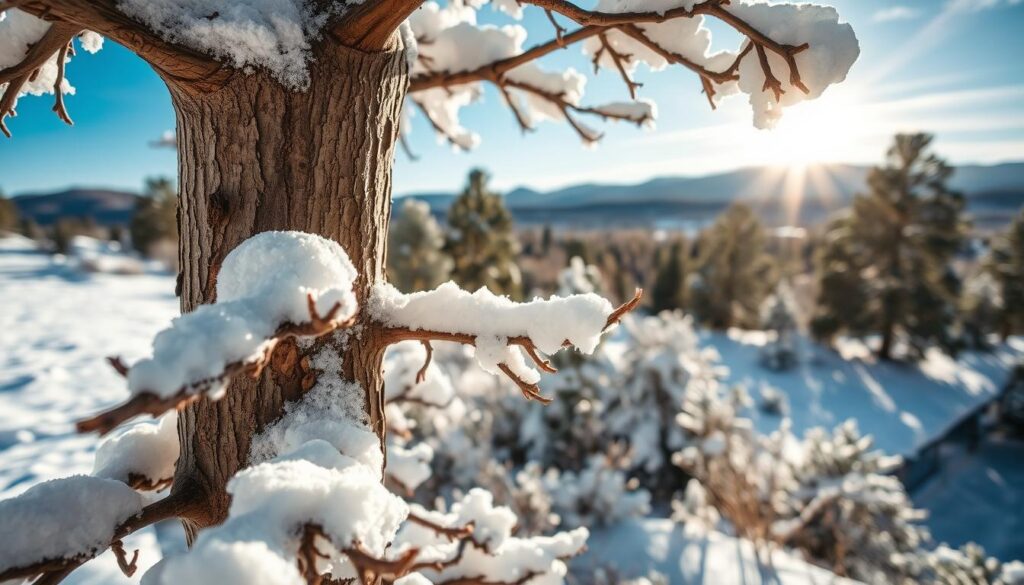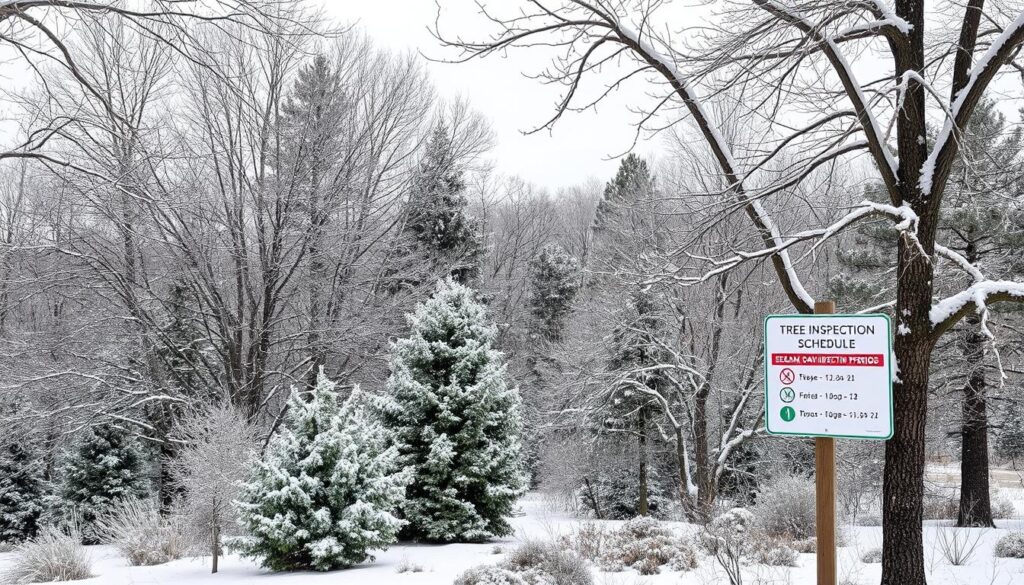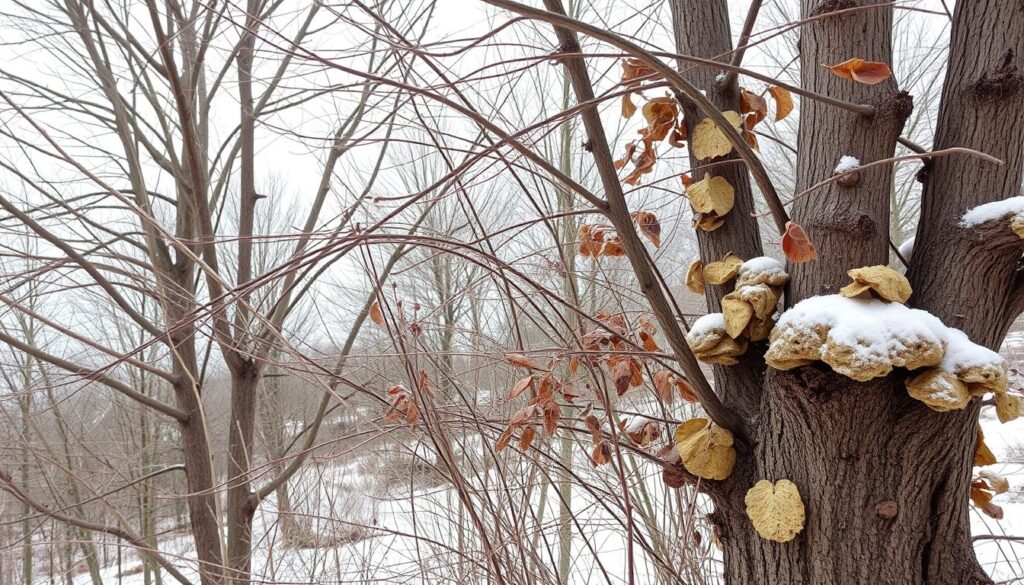
Winter tree care in Prescott, Arizona, needs extra attention. The city’s climate is tough for trees, making regular checks important. Keeping trees healthy is key to Prescott’s beauty and safety.
Winter in Prescott is harsh, stressing trees and making them vulnerable to diseases. Regular checks can spot problems early. This saves trees and keeps Prescott green.
Local arborists suggest a detailed plan for tree checks. They recommend inspecting trees often during winter. This way, trees stay healthy, and Prescott’s green spaces thrive.
Key Takeaways
- Regular winter inspections are vital for tree health in Prescott
- Prescott’s climate creates unique challenges for cold-weather tree care
- Early detection through inspections can prevent serious tree diseases
- Structured inspection schedules help maintain urban forest health
- Professional arborists recommend tailored inspection plans for Prescott trees
Winter Tree Disease Inspection Schedule for Prescott’s Climate
Prescott’s climate is unique, needing a special winter tree schedule. Regular checks are key to keeping trees healthy in the cold. A good schedule helps spot problems early.

Early Winter Inspection Timeline
Begin your tree health checks in November. Look for signs of stress from fall weather. Check for:
- Discolored leaves
- Cracked bark
- Fungal growth
These early checks are important for caring for trees in the cold.
Mid-Season Check Points
December and January are important for tree health. During these months:
- Examine branches for snow damage
- Look for pest activity under the bark
- Check soil moisture levels
Regular checks in mid-winter help catch problems early.
Late Winter Assessment Requirements
As spring gets closer, focus on:
- Pruning needs
- Root health
- Overall tree structure
These late checks get trees ready for spring. A detailed winter inspection schedule protects your trees in Prescott’s tough climate. This article is a gem – take the time to read it.
Common Tree Diseases to Watch for in Prescott’s Winter Months
Prescott’s winter months pose challenges for tree health. Knowing about winter tree diseases is key to protecting your trees. Let’s look at the main Prescott tree pathogens active during the cold season.
Bark Beetles and Their Winter Activity
Bark beetles are a problem even in the cold. They burrow into tree bark, creating small holes and leaving behind sawdust-like frass. Watch for these signs:
- Pitch tubes on tree trunks
- Discolored or peeling bark
- Increased woodpecker activity
Fungal Infections in Dormant Trees
Fungal diseases flourish in winter’s dampness. Common winter tree diseases include:
- Cytospora canker on pines and spruces
- Phomopsis blight on junipers
- Diplodia tip blight on pines

Root Disease Detection During Cold Seasons
Root diseases can get worse in the dormant season. Look out for these signs:
- Thinning canopy
- Yellowing needles or leaves
- Fungal growth at tree base
Regular checks can catch these Prescott tree pathogens early. Acting quickly against winter tree diseases ensures your trees stay healthy come spring.
Professional vs DIY Tree Inspection Methods
Winter tree monitoring needs different methods based on your skills and tools. DIY tree care works well for simple checks. But, professional arborist services are key for complex problems.
Tools Needed for Winter Tree Assessment
For DIY tree care, you’ll need:
- Binoculars for viewing high branches
- Magnifying glass for close-up bark examination
- Pruning shears for small sample collection
- Camera for documenting observations
Signs That Require Professional Intervention
Some signs need a pro’s touch:
- Large dead branches or extensive dieback
- Fungal growths on the trunk or major limbs
- Significant bark damage or unusual coloration
- Signs of pest infestation beyond surface level
Documentation and Monitoring Techniques
Good winter tree monitoring means keeping records. Make a log of your observations, dates, and actions. Photos are great for tracking changes.
Check your trees regularly, ideally every month. This helps spot problems early and keeps your trees healthy.
Impact of Prescott’s Unique Climate on Tree Health
Prescott’s microclimate greatly affects the health of Arizona trees. The city’s high elevation and semi-arid conditions pose challenges for trees in winter. Trees must be cold hardy to survive the temperature drops, especially at night.
Over time, many Arizona tree species have adapted to Prescott’s climate. Ponderosa pines and junipers, for example, show great resilience to winter stress. Their thick bark and deep roots help them endure freezing temperatures and dry spells.
The cold temperatures and low humidity in Prescott can cause winter desiccation. This happens when trees lose more water than they can absorb from frozen soil. To fight this, some trees go dormant, using less water until spring.
- Soil freezing limits water uptake
- Sunny winter days increase water loss
- Wind exposure amplifies stress on trees
Prescott’s varied terrain creates different microclimates within the city. Trees in valleys may face colder temperatures due to frost pockets. Trees on hillsides might deal with stronger winds. Knowing these local differences is crucial for keeping trees healthy during winter.
Preventive Measures and Treatment Timing
Winter tree protection in Prescott starts with a proactive approach. Inspect your trees in late fall, before the cold hits. This gives you time to apply treatments and fix any problems.
Water your trees properly before the ground freezes. This helps them handle winter stress better. Timing is key for seasonal tree treatments. Use dormant oil sprays in late winter, just before spring buds show.
This controls pests that stay active during winter. For preventive care, prune trees in winter when they’re dormant. It’s easier to spot and fix problems without spreading disease.
Use physical barriers to protect your trees from harsh Prescott winters. Wrap young or thin-barked trees with burlap or tree wrap to prevent damage. Mulching around the base keeps roots warm and moist. These steps can greatly improve your trees’ winter resilience.
Yavapai Landscaping Prescott offers no-cost estimates for their landscaping and tree services for Prescott and the neighboring regions. This includes tree elimination, pruning, stump grinding, land clearance, storm clean-up, and emergency tree care.
